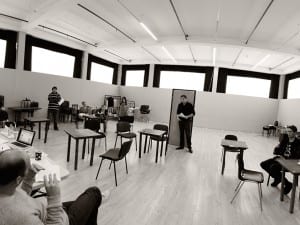If a company and one of its employees create an algorithm, and, subsequent to the dissolution of the company and the death of the programmer, that algorithm causes human deaths, can it be held responsible?
This is the question ostensibly at the heart of Helen Knowles’ The Trial of Superdebthunterbot, a piece of conceptual art – documented here as a film and selection of courtroom-style pastel drawings – where the algorithm in question is tried at Southwark Crown Court subject to the prosecution and defence of two trained lawyers, and judged by a jury of volunteers. Adding somewhat to the experience, and to the way in which we are given to view the film, the audience is provided a kind of jury stand to sit on and the pastel images are hung on the walls around.
It should be clear, given the current state of AI technology, that the defendant is neither innocent nor guilty. What is interesting, though, is the strange allegory the trial constructs, and the human questions it raises once the aura of sci-fi is stripped away. The term “algorithm” describes only a set of instructions – a step-by-step course of action – used to solve a given problem. It shouldnt be confused for some kind of being or intelligence, but thought of rather as a tool. It can learn, in a sense, but only within the remit given it by a human whose capacity for originality it lacks.
To hold one of these phenomena culpable for a crime would be akin to a country using viral weaponry and the international criminal court prosecuting the virus – a non-sentient but self-reproducing organism with its own, limited “programming.” It is, in a sense, always a reproduction. There can be no extant original. It has no individuality, and so how can it be culpable?
Its lack of humanity enables a kind of moral cleanliness around it, an especially cold dialectic that reflects with unusual purity the intended directness of the law. This becomes especially interesting when one reflects the line of questioning that we apply back onto people. To what extent, for instance, are any of us original? Our culture too is based on reproduction, as are our ideas, ethics, and economics.
The counsel for the prosecution in Knowles’ trial tells the jury at one point that to hold the programmer responsible for the crime would be like holding the parents responsible for the wrongdoings of a child, to which one can only wonder: to what extent do we already, or should we? These nature/nurture arguments are interesting in a philosophical sense, but then so too is a larger question – one that borders on the absurd before it becomes so acutely relevant – about the purpose of having such a trial at all: what is the point of punishing something that cannot suffer? And what does the necessity of such a question say about the ethics of our society and its carceral system?
If the perpetrator of a crime can be quickly and efficiently “re-educated” – as a computer programme can – would this not be the preferred course of action, or are we on shaky moral ground? If something is sufficiently sentient to be punished, surely it must also be entitled to rights.
Within the complex hierarchical networks of power and authority in which we all live, where people on every point of the political spectrum argue for more culpability for some and less for others, the extent to which our being subject to instructions and influences mitigates our responsibility is in constant question. This exhibition considers the calculation of guilt, and does so in a compelling and self-reflexive manner.
Ned Carter Miles
Zabludowicz Collection Invites: Helen Knowles runs until 26 February. Find out more: www.zabludowiczcollection.com
Credits:
1. Helen Knowles, Installation View of The Trial of Superdebthunterbot, 2016, 45 minutes HD Video / birch ply and leatherette jury bench.




